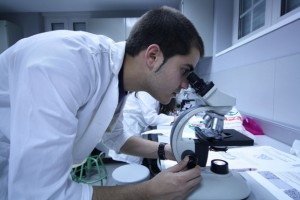Playlist
Show Playlist
Hide Playlist
Nucleophilic Substitution and Sn2 Reaction – Haloalkanes
-
Slides 04 Chemistry Advanced Le Gresley.pdf
-
Download Lecture Overview
00:01 So, what does it mean? You recall when we started talking about the idea of nucleophiles and electrophiles we used Nu- just to represent an ideal nucleophile. In this scenario, what happens in the case of a good nucleophile is that it attacks the delta+ charge on the carbon of our haloalkane in a solvent at a specific temperature. It, then, kicks off the halogen, leaving as it does, as a halide. And the possible parameters that influence this reaction are manifold - the density of the nucleophile, the leaving group. And this gives rise to two possible pathways - the so called SN2 and SN1 pathway. We’re going to discuss those now. Let’s start off with the SN2 reaction. All of that abbreviation means is that it is substitution nucleophilic bimolecular. And in terms of the reaction mechanism, you will understand why it is bimolecular rather than unimolecular. 01:05 In the case of, for example, sodium hydroxide, which produces a good, strong nucleophile in the form of OH-, can attack at the carbon which is delta+ on our bromoalkane. In this case, it is 2-bromobutane, our old friend from before. And what this can do is invert the stereochemistry; in fact, SN2 reactions carry out that inversion. And why I mean inversion is if you look at the species on your screen, which is S in steric chemistry, I’d recommend that you go back to when we talked about stereochemistry for Cahn-Ingold-Prelog rules. Note what’s happening here. In the case of our S steric chemistry, the bromine takes priority, but in the case of sodium hydroxide, when it attacks, it attacks from behind. In doing so, the priority now falls on the OH group and the bromide ion is lost, thus changing the order of priority on that central carbon, which is stereogenic. 02:09 This inversion of the stereochemistry can be shown here, where, for example, we have the bromine which, in its current form, where the current stereochemistry is given, results in an S enantiomer, we can invert that enantiomer by a nucleophilic attack by hydroxide from the rear. This kicks off the bromide ion as effectively as it is attacking on the opposite side of the leaving group. As both the nucleophile and the substrate (here, the 2-bromobutane) are participating in the main step in the reaction mechanism, it is said to be bimolecular. That is to say the reaction rate, not to do with the thermodynamics or the equilibrium constant, but the reaction rate, is dependent upon the concentration of our haloalkane (bromobutane) and also the concentration of our hydroxide anion. 03:01 The rate is dependent on these and is given in the equation below where the rate is proportional, although not necessarily always equal directly to, R-X (our haloalkane) and OH-. This is bimolecular. And the reason for this should be relatively easy to see. The more hydroxide you have and the more haloalkane you have, the greater the likelihood of them coming together. It’s the basic principle of collision theory. So, the more you have of either, the more likelihood the reaction is to occur. And in fact, the reaction is dependent upon those two coming together. Let’s have a look at the reaction parameters.
About the Lecture
The lecture Nucleophilic Substitution and Sn2 Reaction – Haloalkanes by Adam Le Gresley, PhD is from the course Organic Chemistry.
Included Quiz Questions
What attacks a good nucleophile?
- The electron deficient carbon of a haloalkane
- The electron dense carbon of a haloalkane
- The electron dense halogen of a haloalkane
- The electron deficient halogen of a haloalkane
- The hydrogen atom of the terminal carbon on a haloalkane
During the nucleophilic attack on a haloalkane, a halogen…
- …leaves as a halide ion
- … leaves as a halogen atom
- …leaves as a hydrohalic acid
- …switches its position from the terminal to the central carbon atom
- …displaces the hydrogen from haloalkane
The 2-bromopentane gives the SN2 reaction with…
- NaOH
- H₂O
- CH₃OH
- H₂S
- CH₃SH
SN2 (Substitution Nucleophilic Bimolecular) reactions are…
- …stererospecific
- …unimolecular
- …only substrate concentration dependent
- …only nucleophile concentration dependent
- …controlled by the leaving halide
The reaction of 2-bromobutane with sodium hydroxide displays SN2 type reaction because…
- …the reaction rate depends on both nucleophile and substrate concentrations
- …OH⁻ ions are produced in excess
- …Na⁺ ions extract the bromide from the substrate
- …bromide stimulates the dissociation of NaOH into ions
- …NaOH acts as a catalyst
Customer reviews
5,0 of 5 stars
| 5 Stars |
|
5 |
| 4 Stars |
|
0 |
| 3 Stars |
|
0 |
| 2 Stars |
|
0 |
| 1 Star |
|
0 |




